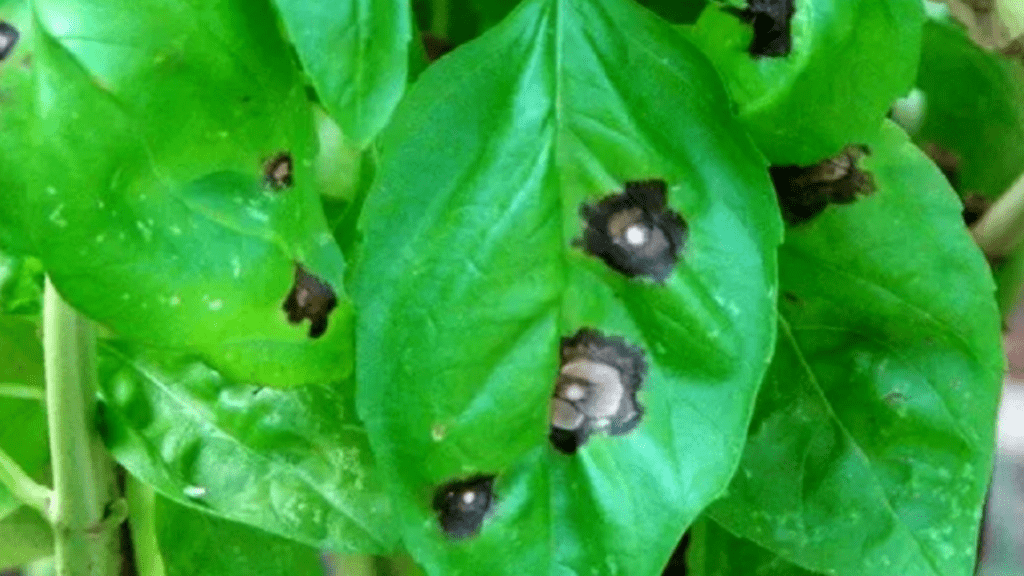
Black Spots on Basil: Causes, Prevention, and Solutions
Basil is a popular and versatile herb used in many culinary dishes, but it can be frustrating to see black spots develop on its leaves. In this article, we’ll delve into the causes of black spots on basil plants and provide practical tips for preventing and treating this issue. Whether you’re a seasoned gardener or a beginner, you’ll find valuable information to keep your basil plants healthy and thriving. Let’s dive in and learn how to address this common problem.
Table of Contents
ToggleUnderstanding Black Spots on Basil
Definition and description of black spots.
Black spots on basil are a common issue that many gardeners encounter. These black spots can appear on the leaves of the basil plant and are often caused by fungal diseases such as downy mildew or botrytis. These diseases thrive in moist and humid conditions, so it’s important to keep the basil plant’s foliage dry and avoid over-watering. Additionally, poor air circulation around the plant can contribute to the development of black spots.
To prevent black spots on basil, it’s important to grow the plant in well-draining soil and provide adequate spacing between plants to allow for good air circulation. Water the plant at the base to avoid wetting the foliage, and prune any affected leaves to prevent the spread of the disease.
If black spots have already developed on your basil plant, there are a few solutions to consider. Fungicides can be used to treat fungal diseases, and it’s essential to remove and dispose of any infected plant material to prevent further spread. Additionally, ensuring that the plant has proper air circulation and sunlight can help to prevent the recurrence of black spots.
By understanding the causes of black spots on basil and taking proactive measures to prevent and address them, you can keep your basil plants healthy and vibrant. With the right care and attention, you can enjoy a bountiful harvest of this flavorful and aromatic herb.
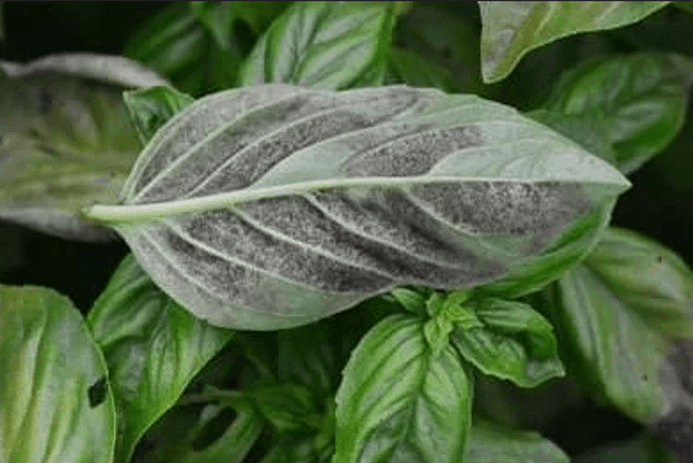
Common symptoms to look for.
When it comes to basil plants, there are a few common symptoms to look out for when trying to prevent black spots. One of the main things to watch for is the development of dark, black spots on the leaves of the plant. This can be a sign of a fungal disease, which can be caused by overwatering, poor air circulation, or high humidity. In addition to black spots, you may also notice wilting or yellowing of the leaves, as well as stunted growth. If you notice any of these symptoms, it’s important to take action to address the issue. By following proper care and maintenance techniques, such as providing good air circulation, keeping the foliage dry, and pruning affected leaves, you can help prevent the development of black spots on your basil plants. If the issue has already developed, consider using fungicides and removing infected plant material to stop the spread of the disease. By being proactive and attentive to the health of your basil plants, you can ensure that they remain healthy and vibrant.
Subsection: Visual signs and impact on plant health.
Visual signs can have a significant impact on the health of your plants. For example, the development of dark, black spots on the leaves of the plant can be a sign of a fungal disease, which can be caused by overwatering, poor air circulation, or high humidity. In addition to black spots, you may also notice wilting or yellowing of the leaves, as well as stunted growth. It’s important to take action if you notice any of these symptoms to address the issue and prevent further damage to your plants. By following proper care and maintenance techniques, such as providing good air circulation, keeping the foliage dry, and pruning affected leaves, you can help prevent the development of black spots on your basil plants. If the issue has already developed, consider using fungicides and removing infected plant material to stop the spread of the disease. By being proactive and attentive to the health of your basil plants, you can ensure that they remain healthy and vibrant.
Causes of Black Spots on Basil
Environmental factors (humidity, temperature, sunlight).
Environmental factors such as humidity, temperature, and sunlight can have a significant impact on the health of your plants, especially when it comes to the development of black spots on basil leaves. High humidity can create a damp environment that is conducive to the growth of fungi, leading to the development of black spots on the leaves. Similarly, extreme temperatures, especially heat, can stress the plant and make it more susceptible to fungal infections. Inadequate sunlight or poor air circulation can also contribute to the development of black spots on basil leaves.
To prevent black spots on basil leaves, it’s important to ensure that the plant is kept in a well-ventilated area with good air circulation. Additionally, it’s important to water the plant at the base and avoid getting the foliage wet, as damp leaves can create an environment for fungal growth. Providing adequate sunlight and maintaining a consistent temperature can also help prevent the development of black spots on basil leaves.
If black spots do develop, it’s important to take action to address the issue. This may involve removing infected leaves, using fungicides, and adjusting environmental conditions to create a less hospitable environment for fungal growth. By being proactive and attentive to the environmental factors that can contribute to the development of black spots on basil leaves, you can help ensure the health and vitality of your plants.
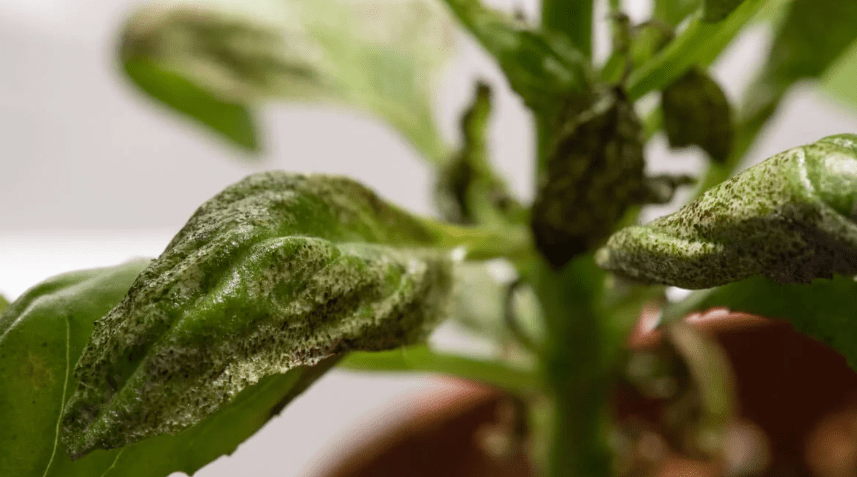
Pests and insects (aphids, spider mites).
Pests and insects such as aphids and spider mites can be a common issue when growing basil plants. These pests can cause damage to the leaves and can impact the overall health of the plant. To prevent and address these issues, it’s important to regularly inspect your basil plants for any signs of pests and insects. You can use natural remedies such as neem oil or insecticidal soap to control and eliminate these pests. Additionally, maintaining proper plant hygiene, such as removing any dead or damaged leaves, can help prevent infestations. It’s also important to avoid overwatering and to provide adequate air circulation to reduce the risk of pest infestations. By staying vigilant and taking proactive measures, you can keep your basil plants healthy and free from pest and insect issues.
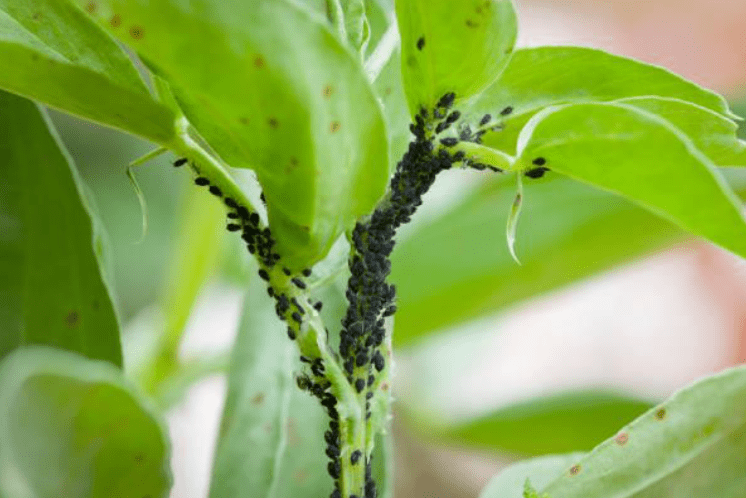
Diseases (fungal infections, bacterial leaf spot).
Fungal infections and bacterial leaf spot are common diseases that can affect basil plants. Fungal infections can cause issues such as yellowing or browning of the leaves, wilting, and a fuzzy growth on the leaves or stems. Bacterial leaf spot can cause dark, water-soaked spots on the leaves, which can eventually lead to the leaves turning yellow and falling off. To prevent these diseases, it’s important to avoid overhead watering and to water the plants at the base to keep the foliage dry. Additionally, providing good air circulation and spacing out the plants can help prevent the spread of these diseases. If your basil plants do develop fungal infections or bacterial leaf spot, you can use fungicides or bactericides to address the issue. It’s also important to remove and dispose of any infected plants or leaves to prevent the spread of the diseases. Regularly inspecting your basil plants for any signs of diseases and taking prompt action can help keep your plants healthy and thriving.
Prevention Strategies
Proper planting techniques.
Proper planting techniques are essential for preventing fungal infections and bacterial leaf spot in basil plants. These infections can cause issues such as yellowing or browning of the leaves, wilting, and a fuzzy growth on the leaves or stems. To prevent these diseases, it’s important to avoid overhead watering and to water the plants at the base to keep the foliage dry. Providing good air circulation and spacing out the plants can also help prevent the spread of these diseases. If your basil plants do develop fungal infections or bacterial leaf spot, you can use fungicides or bactericides to address the issue. It’s also important to remove and dispose of any infected plants or leaves to prevent the spread of the diseases. Regularly inspecting your basil plants for any signs of diseases and taking prompt action can help keep your plants healthy and thriving. By implementing these proper planting techniques and prevention strategies, you can ensure that your basil plants stay disease-free and continue to thrive.
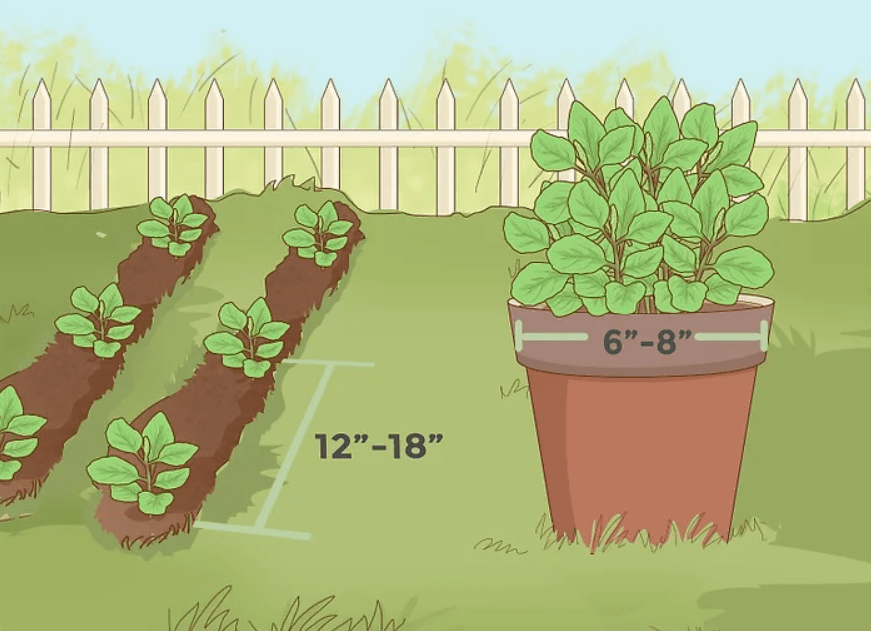
Optimal watering and soil conditions.
In order to keep your basil plants healthy and disease-free, it’s important to provide optimal watering and soil conditions. Basil plants prefer well-drained soil and should be watered consistently, but not excessively. Over-watering can lead to root rot and other fungal diseases, so it’s important to let the soil dry out slightly between waterings. Additionally, it’s important to avoid getting the foliage of the plants wet, as this can lead to fungal and bacterial infections. These infections can cause issues such as yellowing or browning of the leaves, wilting, and a fuzzy growth on the leaves or stems. To prevent these diseases, it’s important to avoid overhead watering and to water the plants at the base to keep the foliage dry. Providing good air circulation and spacing out the plants can also help prevent the spread of these diseases. If your basil plants do develop fungal infections or bacterial leaf spot, you can use fungicides or bactericides to address the issue. It’s also important to remove and dispose of any infected plants or leaves to prevent the spread of the diseases. Regularly inspecting your basil plants for any signs of diseases and taking prompt action can help keep your plants healthy and thriving. By implementing these proper planting techniques and prevention strategies, you can ensure that your basil plants stay disease-free and continue to thrive.
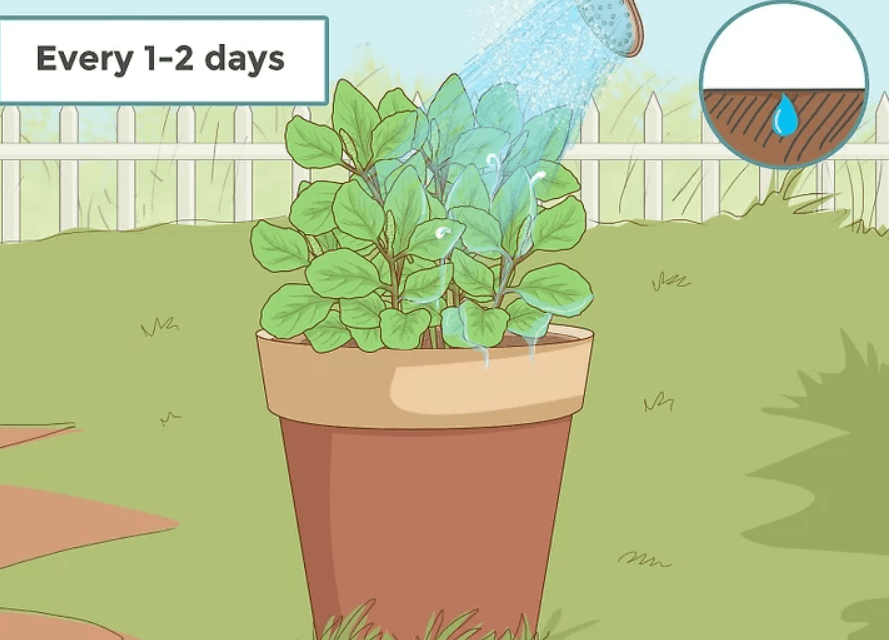
Ensuring adequate airflow and spacing.
It’s important to ensure adequate airflow and spacing for your plants to prevent the spread of diseases. Fungal infections and bacterial leaf spot can cause issues such as yellowing or browning of the leaves, wilting, and a fuzzy growth on the leaves or stems. To prevent these diseases, it’s important to avoid overhead watering and to water the plants at the base to keep the foliage dry. Providing good air circulation and spacing out the plants can also help prevent the spread of these diseases. If your basil plants do develop fungal infections or bacterial leaf spot, you can use fungicides or bactericides to address the issue. It’s also important to remove and dispose of any infected plants or leaves to prevent the spread of the diseases. Regularly inspecting your basil plants for any signs of diseases and taking prompt action can help keep your plants healthy and thriving. By implementing these proper planting techniques and prevention strategies, you can ensure that your basil plants stay disease-free and continue to thrive.
Treatment Solutions
Immediate steps to take when you notice black spots.
When you notice black spots on your plants, it’s important to take immediate action to prevent the spread of fungal infections or bacterial leaf spot. First, make sure to avoid overhead watering and water the plants at the base to keep the foliage dry. Good air circulation and spacing out the plants can also help prevent the spread of these diseases. If your basil plants do develop fungal infections or bacterial leaf spot, you can use fungicides or bactericides to address the issue. It’s also important to remove and dispose of any infected plants or leaves to prevent the spread of the diseases. Regularly inspecting your basil plants for any signs of diseases and taking prompt action can help keep your plants healthy and thriving. By implementing these proper planting techniques and prevention strategies, you can ensure that your basil plants stay disease-free and continue to thrive.
Natural remedies (neem oil, garlic spray).
If you notice black spots on your plants, it’s important to take immediate action to prevent the spread of fungal infections or bacterial leaf spot. One natural remedy you can use is neem oil, which has antifungal and antibacterial properties. You can mix neem oil with water and spray it on your plants to help control the spread of these diseases. Another natural remedy is garlic spray, which has natural antifungal and antibacterial properties. You can make a garlic spray by blending garlic cloves with water and straining the mixture to create a concentrated liquid. Dilute the concentrated liquid with water and spray it on your plants to help prevent the spread of fungal infections and bacterial leaf spot.
In addition to using natural remedies, it’s important to take preventative measures to keep your plants healthy. Avoid overhead watering and water the plants at the base to keep the foliage dry, as moisture on the leaves can promote the spread of diseases. Good air circulation and spacing out the plants can also help prevent the spread of these diseases. If your basil plants do develop fungal infections or bacterial leaf spot, you can use fungicides or bactericides to address the issue. It’s also important to remove and dispose of any infected plants or leaves to prevent the spread of the diseases.
Regularly inspecting your basil plants for any signs of diseases and taking prompt action can help keep your plants healthy and thriving. By implementing these proper planting techniques and prevention strategies, you can ensure that your basil plants stay disease-free and continue to thrive.
Chemical treatments (fungicides, insecticides).
When it comes to protecting your plants from diseases and pests, it’s important to take preventative measures. This includes avoiding overhead watering and watering the plants at the base to keep the foliage dry, as moisture on the leaves can promote the spread of diseases. Good air circulation and spacing out the plants can also help prevent the spread of these issues. However, if your basil plants do develop fungal infections or bacterial leaf spot, you can use fungicides or bactericides to address the issue. It’s important to remove and dispose of any infected plants or leaves to prevent the spread of the diseases. Regularly inspecting your plants for any signs of diseases and taking prompt action can help keep your plants healthy and thriving. By implementing these proper planting techniques and prevention strategies, you can ensure that your basil plants stay disease-free and continue to thrive.
Long-term Maintenance and Care
Best practices for ongoing basil care.
When it comes to ongoing basil care, there are a few best practices to keep in mind. Firstly, it’s important to provide your basil plants with proper watering and sunlight. Basil plants thrive in well-draining soil and require at least 6-8 hours of direct sunlight each day. Additionally, it’s important to regularly prune your basil plants to encourage new growth and prevent them from becoming too leggy.
In terms of pest control, regularly inspect your basil plants for any signs of pests such as aphids or spider mites. If you do notice any pests, you can use organic pest control methods such as neem oil or insecticidal soap to address the issue.
When it comes to protecting your plants from diseases and pests, it’s important to take preventative measures. This includes avoiding overhead watering and watering the plants at the base to keep the foliage dry, as moisture on the leaves can promote the spread of diseases. Good air circulation and spacing out the plants can also help prevent the spread of these issues. However, if your basil plants do develop fungal infections or bacterial leaf spot, you can use fungicides or bactericides to address the issue. It’s important to remove and dispose of any infected plants or leaves to prevent the spread of the diseases.
Regularly inspecting your plants for any signs of diseases and taking prompt action can help keep your plants healthy and thriving. By implementing these proper planting techniques and prevention strategies, you can ensure that your basil plants stay disease-free and continue to thrive.
Regular monitoring and inspection tips.
When it comes to ensuring the health of your plants, regular monitoring and inspection are key. Keep an eye out for any signs of pests or diseases, such as discoloration, wilting, or unusual spots on the leaves. It’s important to take preventative measures to protect your plants from potential issues. This includes avoiding overhead watering and instead watering the plants at the base to keep the foliage dry, as moisture on the leaves can promote the spread of diseases. Good air circulation and spacing out the plants can also help prevent the spread of these issues. If you do notice any signs of disease or pests, it’s important to take prompt action. You can use fungicides or bactericides to address the issue, and it’s crucial to remove and dispose of any infected plants or leaves to prevent the spread of the diseases. By regularly inspecting your plants and taking preventative measures, you can ensure that your plants stay healthy and continue to thrive.
Subsection: Seasonal care tips for basil.
Basil is a popular herb that requires some specific care, especially during different seasons. It’s important to keep an eye out for any signs of pests or diseases, such as discoloration, wilting, or unusual spots on the leaves. Taking preventative measures, such as avoiding overhead watering and instead watering the plants at the base to keep the foliage dry, can help protect your plants from potential issues. Good air circulation and spacing out the plants can also help prevent the spread of these issues. If you do notice any signs of disease or pests, it’s important to take prompt action. You can use fungicides or bactericides to address the issue, and it’s crucial to remove and dispose of any infected plants or leaves to prevent the spread of the diseases. By regularly inspecting your plants and taking preventative measures, you can ensure that your basil plants stay healthy and continue to thrive throughout the seasons.
Common Mistakes to Avoid
Overwatering and underwatering.
Basil is a popular herb that requires specific care, especially when it comes to watering. Overwatering and underwatering are common mistakes that can affect the health of your basil plants. Overwatering can lead to root rot and other fungal diseases, while underwatering can cause the leaves to wilt and the plant to become stressed.
To avoid overwatering, it’s important to allow the soil to dry out slightly between waterings. Water the plants at the base to keep the foliage dry, as wet leaves can lead to disease. On the other hand, make sure not to let the soil dry out completely, as this can cause the basil plants to become stressed and wilt.
It’s important to find the right balance when it comes to watering your basil plants. Keep an eye on the soil moisture and adjust your watering schedule accordingly. By avoiding overwatering and underwatering, you can help your basil plants stay healthy and thrive.

Ignoring early symptoms.
Ignoring early symptoms of plant distress can lead to serious issues for your basil plants. Overwatering can lead to root rot and other fungal diseases, while underwatering can cause the leaves to wilt and the plant to become stressed. To avoid overwatering, it’s important to allow the soil to dry out slightly between waterings. Water the plants at the base to keep the foliage dry, as wet leaves can lead to disease. On the other hand, make sure not to let the soil dry out completely, as this can cause the basil plants to become stressed and wilt. It’s important to find the right balance when it comes to watering your basil plants. Keep an eye on the soil moisture and adjust your watering schedule accordingly. By avoiding overwatering and underwatering, you can help your basil plants stay healthy and thrive. It’s important to address any early symptoms of distress in your basil plants to ensure their long-term health and productivity.
Using incorrect treatments.
It’s important to be mindful of the watering needs of your plants. Overwatering can lead to root rot and other diseases, while underwatering can cause the plants to become stressed and wilt. To avoid overwatering, it’s important to allow the soil to dry out slightly between waterings. Water the plants at the base to keep the foliage dry, as wet leaves can lead to disease. On the other hand, make sure not to let the soil dry out completely, as this can cause the basil plants to become stressed and wilt. It’s important to find the right balance when it comes to watering your basil plants. Keep an eye on the soil moisture and adjust your watering schedule accordingly. By avoiding overwatering and underwatering, you can help your basil plants stay healthy and thrive. It’s important to address any early symptoms of distress in your basil plants to ensure their long-term health and productivity. Using the correct treatments and being mindful of the specific needs of your plants will help them to thrive and flourish.
In conclusion, it’s important to keep an eye on your basil plants and take preventive measures to avoid black spots. Proper watering, good air circulation, and avoiding overhead watering can help prevent the growth of fungus and the development of black spots. If you do notice black spots on your basil plants, removing infected leaves and using natural fungicides can help treat the issue. By following these tips, you can keep your basil plants healthy and thriving.
Frequently asked questions And Answer
Black spots on basil leaves are typically caused by fungal diseases such as downy mildew or basil leaf spot. These diseases thrive in moist and humid conditions.
To prevent black spots on basil, it’s important to avoid overhead watering, as this can create the moist conditions that fungi thrive in. Make sure to water the soil directly at the base of the plant and provide good air circulation around the leaves.
If you notice black spots on your basil leaves, it’s best to remove the affected leaves immediately to prevent the spread of the disease. You can also apply a fungicide specifically formulated for basil plants to help control the fungal infection.
It’s best to avoid using basil leaves with black spots, as they may affect the flavor and quality of the herb. It’s better to remove the affected leaves and only use healthy ones for culinary purposes.
Some natural remedies for preventing fungal diseases on basil include using neem oil or a mixture of baking soda and water as a foliar spray. These can help to control fungal infections and prevent the development of black spots on the leaves.
It’s a good practice to regularly inspect your basil plants for any signs of disease or pest infestations. Check the leaves and stems for any discoloration or unusual spots, and take action promptly if you notice any issues.
While consuming basil leaves with black spots is not typically harmful, it’s best to avoid using affected leaves for culinary purposes to maintain the quality and flavor of the herb.
In addition to fungal diseases, basil plants can also be susceptible to pest infestations, nutrient deficiencies, and environmental stress. It’s important to provide proper care and maintenance to keep basil plants healthy and thriving.
